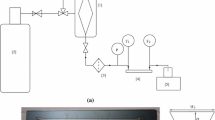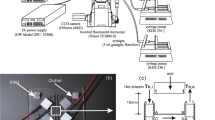Abstract
Non-intrusive local temperature measurement in convective microchannel flows using infrared (IR) thermography is presented. This technique can be used to determine local temperatures of the visualized channel wall or liquid temperature near this wall in IR-transparent heat sinks. The technique is demonstrated on water flow through a silicon (Si) microchannel. A high value of a combined liquid emissivity and substrate overall transmittance coupled with a low uncertainty in estimating this factor is important for quantitative temperature measurement using IR thermography. The test section design, and experimental and data analysis procedures that provide increased sensitivity of the detected intensity to the desired temperature are discussed. Experiments are performed on a 13-mm long, 50 μm wide by 135 μm deep Si microchannel at a constant heat input to the heat sink surface for flow rates between 0.6 and 1.2 g min−1. Uncertainty in fluid temperature varies from a minimum of 0.60°C for a Reynolds number (Re) of 297 to a maximum of 1.33°C for a Re of 251.










Similar content being viewed by others
Abbreviations
- a :
-
absorption coefficient (cm−1)
- D h :
-
channel hydraulic diameter (m)
- e :
-
radiant energy flux (W m−2)
- G :
-
radiant flux incident on the heat sink (W m−2)
- H :
-
height of the channel (m)
- h :
-
local heat transfer coefficient (W m−2 K−1)
- i :
-
location index in channel direction (x direction)
- j :
-
location index in a cross-direction to channel (y direction)
- i′:
-
location index in detector array corresponding to i
- j′:
-
location index in detector array corresponding to j
- \( \ifmmode\expandafter\dot\else\expandafter\.\fi{m} \) :
-
mass flow rate (kg s−1)
- n :
-
refractive index
- Nu:
-
Nusselt number \( ({\text{Nu}} = h\,D_{{\text{h}}}/k) \) (dimensionless)
- q″:
-
heat flux to the heat sink (W m−2)
- Re:
-
Reynolds number \( ({\text{Re}} = V\,D_{{\text{h}}} /\nu ) \) (dimensionless)
- \( \ifmmode\expandafter\bar\else\expandafter\=\fi{R} \) :
-
total reflectance
- S :
-
radiation path length (m)
- t :
-
thickness of the medium (cm)
- T f :
-
fluid temperature (°C)
- V :
-
channel mean velocity (m s−1)
- W :
-
width of the channel (m)
- x i :
-
distance of position i from the channel entrance (m)
- Δ :
-
incremental value
- ε :
-
emissivity
- λ :
-
wavelength
- μ :
-
dynamic viscosity of fluid (Pa s)
- ν :
-
kinematic viscosity of fluid (m2 s−1)
- ρ :
-
surface reflectivity
- τ f :
-
transmittance of water
- b:
-
blackbody
- cal:
-
calibration
- det:
-
detector
- e:
-
emission
- f:
-
fluid
- hsb:
-
heat sink background
- lens:
-
camera lens
- sens:
-
sensed
- Si:
-
Silicon
References
Astarita T, Cardone G, Carlomagno GM, Meola C (2000) A survey of infrared thermography for convective heat transfer measurements. Opt Laser Technol 32:593–610
Bertie JE, Lan Z (1996) Infrared intensities of liquids XX: the intensity of the OH stretching band of liquid water revisited, and the best current values of the optical constants of H2O(l) at 25°C between 15000 and 1 cm−1. Appl Spectrosc 50(8):1047–1057
Carlomagno GM, de Luca L (1989) Infrared thermography in heat transfer. In: Yang WI (ed) Handbook of flow visualization. Hemisphere Publishing Corporation, Washington, DC, pp 531–553
Edwards DF, Ochoa E (1980) Infrared refractive index of silicon. Appl Opt 19(24):4130–4131
Figliola R, Beasley D (2000) Theory and design for mechanical measurements, 3rd edn. Wiley, New York, NY
Ghiaasiaan SM, Abdel-Khalik SI (2001) Two-phase flow in microchannels. Adv Heat Transf 34:145–254
Hapke I, Hartwig B, Schmidt J (2002) Flow boiling of water and n-heptane in microchannels. Microscale Therm Eng 6(2):99–115
Hassan I, Phutthavong P, Abdelgawad M (2004) Microchannel heat sinks: an overview of the state-of-the-art. Microscale Therm Eng 8(3):183–205
Hestroni G, Mosyak A, Segal Z (2001) Non-uniform temperature distribution in electronic devices cooled by flow in parallel channels. IEEE Trans Comp Packaging Technol 24(1):16–23
Hestroni G, Gurevich M, Mosyak A, Rozenblit R (2003a) Surface temperature measurement of a heated capillary tube by means of an infrared technique. Meas Sci Technol 14:807–814
Hestroni G, Mosyak A, Segal Z, Pogrebnyak E (2003b) Two-phase flow patterns in parallel micro-channels. Int J Mulitphase Flows 29:341–360
Hollingworth KD (2004) Liquid crystal imaging of flow boiling in minichannels. In: Proceedings of the 2nd international conference on microchannels and minichannels (ICMM 2004), Rochester, NY, ICMM2004-2320, pp 57–66
Hordvik A, Skolnik L (1977) Photoacoustic measurements of surface and bulk absorption in HF/DF laser window materials. Appl Opt 16(11):2919–2924
Horny N (2003) FPA camera standardization. Infrared Phys Technol 44:109–119
Kandlikar S (2002) Fundamental issues related to flow boiling in minichannels and microchannels. Exp Therm Fluid Sci 26:389–407
Koo JM, Jiang L, Zhang L, Zhou P, Banerjee SS, Kenny TW, Santiago JG, Goodson KE (2001) Modeling of two-phase microchannel heat sinks for VLSI chips. In: Proceedings of the IEEE international conference on micro electro mechanical systems, pp 422–426
Muwanga RS, Hassan IG (2005) Local heat transfer measurements in micro geometries using liquid crystal thermography. In: Proceedings of the 3rd international conference on microchannels and minichannels (ICMM 2005), Toronto, Canada, ICMM2005-75019
Palm B (2001) Heat transfer in microchannels. Microscale Therm Eng 5:155–175
Patil VA, Narayanan V (2005) Measurement of near-wall liquid temperatures in single phase flows through silicon microchannels. In: Proceedings of the 3rd international conference on microchannels and minichannels (ICMM 2005), Toronto, Canada, ICMM2005-75212
Peng XF, Peterson GP (1994) Heat transfer characteristics of water flowing through microchannels. Exp Heat Transf 7:265–283
Popescu A, Welty JR, Pfund D, Rector D (2002) Thermal measurements in rectangular micorchannels. In: Proceedings of the IMEC&E2002, New Orleans, LA, IMECE2002-32442
Qu W, Mudawar I (2003) Flow boiling heat transfer in two-phase micro-channel heat sinks—I. Experimental investigation and assessment of correlation methods. Int J Heat Mass Transf 46:2755–2771
Shah RK, London AL (1978) Laminar flow forced convection in ducts. Supplement 1 to Advances in Heat Transfer, Academic, New York, NY
Siegel R, Howell JR (2002) Thermal radiation heat transfer, 4th edn. Hemisphere Publishing Corporation, Washington, DC
Sobhan CB, Garimella SV (2000) A comparative analysis of studies on heat transfer and fluid flow in microchannel. In: Proceedings of the international conference on heat transfer, pp 80–92
Tso CP, Mahulikar SP (2000) Experimental verification of the role of brinkman number in microchannels using local parameters. Int J Heat Mass Transf 43:1837–1849
Zhang L, Koo JM, Jiang L, Asheghi M, Goodson KE, Santiago J, Kenny TW (2002) Measurements and modeling of two-phase flow in microchannels with nearly constant heat flux boundary conditions. J Microelectromech Syst 11(1):12–19
Acknowledgments
Partial support for the thermography system was provided by the Oregon State University through Research Equipment Reserve Fund grants.
Author information
Authors and Affiliations
Corresponding author
Rights and permissions
About this article
Cite this article
Patil, V., Narayanan, V. Spatially resolved temperature measurement in microchannels. Microfluid Nanofluid 2, 291–300 (2006). https://doi.org/10.1007/s10404-005-0074-3
Received:
Accepted:
Published:
Issue Date:
DOI: https://doi.org/10.1007/s10404-005-0074-3




